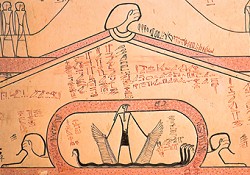
Ancient god, the personification of the earth, quickly overshadowed by the earth god Geb, one of the Ennead of Heliopolis. Texts and representations show how Aker was envisaged. In the Old Kingdom his name was often determined with the earth sign, a flat, wide sign. Representations show the god in this form, with a human head at one side. Desire for symmetry meant that a second head was soon added to the other side and later a lion's forepaws were also added, turning the image into a double sphinx. Occasionally, the solar bark is depicted on the top, between the two heads of Aker. Many tombs in the Valley of the Kings contain such scenes. The meaning behind them is that the sun, after a journey through the earth during the night, reappears out of Aker in the morning. Related to this is the illustration in the Book of the Dead of two lions sitting back to back, between whose backs the sun is depicted rising out of the horizon. The texts call these two lions the personification of the east and the west, or of yesterday and tomorrow, but also the lion pair Shu and Tefnut. A headrest from the tomb of Tutankhamun not only has a depiction of the two lions, but also of Shu supporting the head, the symbol of the sun. Besides being a god symbolising on the one hand the darkness of the stay in the earth, a place feared by the dead, Aker was on the other someone who helped the deceased. Aker not only guarded the snakes that lived in the earth and threatened the deceased (just as he protects the sun god from Apophis), but the deceased could also arise from Aker into the day. For this reason, amulets in the form of Aker were given to the deceased.